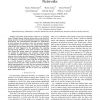545 search results - page 64 / 109 » Minimum energy accumulative routing in wireless networks |
CCR
2002
13 years 8 months ago
2002
An ad hoc network is a fast deployable selfconfiguring wireless network characterized by node mobility, dynamic topology structure, unreliable media and limited power supply. Node...
AINA
2007
IEEE
14 years 3 months ago
2007
IEEE
In this paper we propose a distributed, self organizing, robust and energy efficient data gathering algorithm for sensor networks operating in environments where all the sensor n...
IFIP
2004
Springer
14 years 2 months ago
2004
Springer
Abstract— An ad hoc wireless network is an autonomous selforganizing system of mobile nodes connected by wireless links where nodes not in direct range communicate via intermedia...
WOWMOM
2005
ACM
14 years 2 months ago
2005
ACM
Ad-hoc wireless networks with multi-rate radios (such as 802.11a, b, g) require a new class of MAC/PHY aware metrics that take into account factors such as physical-layer link spe...
INFOCOM
2007
IEEE
14 years 3 months ago
2007
IEEE
— Dual-radio, dual-processor nodes are an emerging class of Wireless Sensor Network devices that provide both lowenergy operation as well as substantially increased computational...

